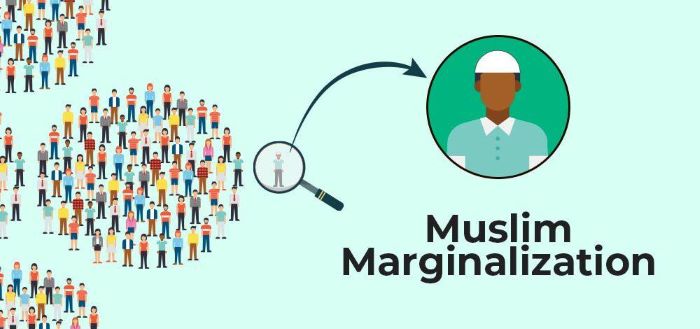Equity Question of Muslim is a Myth India Finds a Report
You are Here: Tweet, Like, Share, Comment, Subscribe…be the Voice of Free Press!
By Syed Ali Mujtaba, Edited By Adam Rizvi, The India Observer, TIO, NJ: An audit report on the marginalization of Muslims in minority concentration districts in Bihar, West Bengal, Assam, and UP tears apart the slogan sab ka sath, sab ka Vikas and says the equity question of Muslims remains a myth in India.
The audit focused on ten districts that have a significant Muslim population of approximately 14.1 million, representing 52% of the district’s overall population. It was presented at the Press Club of India on April 15, 2023, in New Delhi.

Also Read, Tweet & Share: “The Problem with Nirmala Sitharaman’s Assertion: Why Linking the Well-being of Muslims in India to their Population Growth is Flawed”
The ten districts on which the report focused are four in Bihar, (Araria, Purnea, Kishanganj, Katihar), two in Assam, (Dhubri, Kokrajhar), two in West Bengal (Malda, Murshidabad), and two in UP, Shravasti and Balrampur.
In these ten districts, there are about 1.4 crore Muslims, or 5% of the total Muslim population in India.
According to the report, the Muslim population in the ten selected districts has been deprived of basic resources and amenities more than other regions of the country.
Also Read, Tweet & Share: At Congressional Briefing on Gujarat Pogrom, USCIRF Commissioner Steve Schneck says US must condemn Modi’s anti-minority policies.
The report highlighted systematic discrimination against Muslims in the distribution of government schemes. Only 31.20% of the beneficiaries of the Pradhan Mantri Gramin Awaas Yojana (PMGAY) in these districts were Muslims, which is 17.5% less than the Muslim population’s total average.
The report dispels the misconception that Pasmandas (backward) Muslims received a proportionate share in the PMGAY scheme. They received only 31.20% of the allotments in one district which made up 48% of the population and in the rest of the districts, their share was much lower.
Also Read, Tweet & Share: Scholarship to minority Discontinued: Government’s decision
The report also revealed that there was a higher demand for work under the Mahatma Gandhi National Rural Employment Guarantee Act (MGNREGA) in these districts than the state average between 2014-15 and 2020-21.
The report highlighted the poor socioeconomic conditions of Muslims in four districts of Bihar. These districts had lower literacy rates than the state average, and the student-teacher ratio in schools was also significantly higher than the state average, indicating inadequate educational infrastructure.
Also Read, Tweet & Share: Only 3 percent of Muslims are in Indian National Media, says Yogendra Yadav
The report revealed the lack of infrastructure facilities in all the districts with a large concentration of Muslim population.
The data further reveals that only 16.8% of women in Balrampur UP have completed ten or more years of schooling. The state average is 39.3%. In the Shravasti district in UP there exists poor health infrastructure, making it the poorest-ranking district in Uttar Pradesh.
Also Read, Tweet & Share: Bihar- Five Muslims get Ministerial Berth- Operation Lotus Fails
The report discredits the myth of population explosion among Muslims in two districts of Uttar Pradesh. In Shravasti, the Decadal Population Growth (DPG) was 5.02% in 2001-11 which represents a decline of 32.23% from the previous decade. In Balrampur, the DPG increased marginally compared to other districts. The literacy level in both districts was lower than the state average, with Balrampur at 49.51% and Shravasti at 37.89%, compared to the state average of 57.25%.
The report reveals that the situation is similar in the two districts of Assam. Kokrajhar has witnessed a decline in the number of functional lower primary schools, while Dhubri and Kokrajhar both have poor infrastructure and healthcare facilities.

Also Read, Tweet & Share: “Jai Shri Ram” has become a murderous chant to kill Muslims in India
In West Bengal, the report indicates that the decadal population growth in both Malda and Murshidabad, where Muslims make up 51% and 66% of the population, was negative. The report also highlights the poor state of education and health infrastructure in these districts of West Bengal.
SPECT Foundation is a nonprofit organization that has carried out a development audit in ten districts to highlight the socio-economic status of Muslims in India. It intends to carry out a similar exercise in all 90 districts of the country as recommended in the Sachar Commission Report of 2006.
Also, Read more from this Author: Operation Samadhan-Prahar: To steal the “right to life” of the Adivasis
Articles written by contributors have different viewpoints. The views expressed in the articles are the author’s own and not necessarily supported by TIO, The India Observer its affiliates, staff, or the management. Our Articles can be reproduced, with the following conditions, (1) No alteration to the content, (2) Visible, and full credit is given to the Author & Editor. (3) Citing, The India Observer, TIO. In the case of online or electronic media, a link to the original article must be given. Rules are strictly enforced. Any questions, email the Editor at: Mediaiss@gmail.com Or TheIndiaObserver@gmail.com
All Copyrights reserved. Please be guided.




